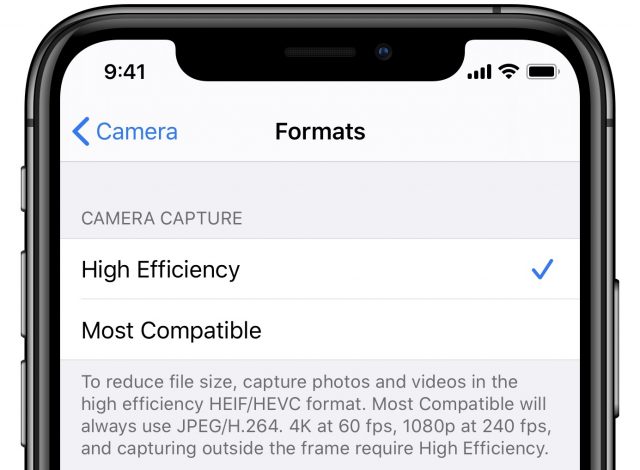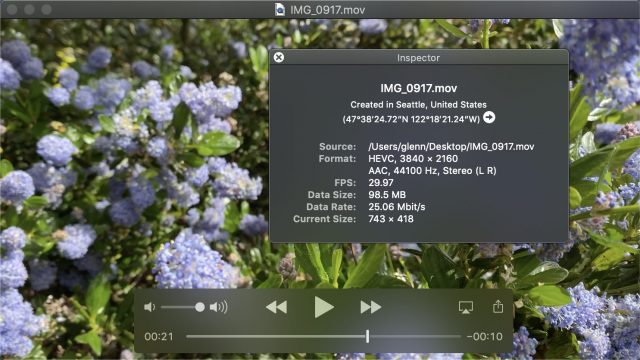What the HEIC? Apple’s Highly Compressed Image Format Still Confuses
To store more photos and videos on a mobile device, you can either buy more storage or increase image compression. Apple has enabled both paths. It expanded maximum storage so that a 256 GB iPhone isn’t ludicrously expensive. But that gets you only part of the way there.
In 2017, Apple added support for successors to JPEG for images and H.264 for video:
- HEIF (High Efficiency Image File Format) is a container format that allows extensive metadata, still images, and sequences (like bursts or Live Photos) to co-exist in a single file.
- HEVC (High Efficiency Video Coding), also known as H.265, can encode video using 40–50% less data than H.264 while maintaining the same quality.
(For the technical nitty-gritty, read “HEVC and HEIF Will Make Video and Photos More Efficient,” 30 June 2017.)
Despite all of this happening nearly three years ago, we at TidBITS found ourselves scratching our heads recently about HEIF and HEVC. While Apple uses those terms, files created using those schemes are stored, respectively, with the filename extensions .heic and .mov. (This came up because of the College Board mishandling iPhone images. See “Take a HEIC: Make Sure AP and Other Test Uploads Work from Your iPhone and iPad,” 21 May 2020.)
The former, HEIC, apparently stands for High Efficiency Image Container—more on that in a moment. The latter is potentially even more confusing since MOV files have been around for decades. MOV is a video container format that can hold media encoded in many different ways, including HEVC.
 Apple discusses HEIF and HEVC in various places, including in Settings > Camera > Formats, where you choose between High Efficiency for the newer formats and Most Compatible for JPEG and H.264—though H.264 is also stored in a MOV container. But the company doesn’t mention HEIC or the use of MOV for storing HEVC—even on the page on which it explains HEIF and HEVC.
Apple discusses HEIF and HEVC in various places, including in Settings > Camera > Formats, where you choose between High Efficiency for the newer formats and Most Compatible for JPEG and H.264—though H.264 is also stored in a MOV container. But the company doesn’t mention HEIC or the use of MOV for storing HEVC—even on the page on which it explains HEIF and HEVC.
Since we couldn’t easily sort it out despite the fact that we live and breathe this kind of thing, we spent some time teasing it all apart for you.
HEVC
H.265, which is just another name for HEVC, provides substantial improvements in compression by being more clever and versatile in analyzing individual frames of video and then equally smart in storing differences between adjacent frames. HEVC can compress still images or sequences of video.
HEIF
HEIF is a container format developed by the Moving Picture Experts Group, which has created many licensed audio and video formats. HEIF is used for still images. It supports an image stored by itself, potentially with added modification layers from an image-editing program, alpha masking, and depth layers. It also allows for multiple images stored as a sequence (such as a burst mode) or to enable simple animation (as with Live Photos).
You can think of a container format as a sort of folder within a file. Older image formats like GIF, JPEG, PNG, and TIFF pack metadata into the image file, usually at the start. A long-ago change to GIF allowed the integral storage of multiple frames for animations, and TIFF can support multiple pages in a single file. But each of these options requires, in effect, unpacking the entire file. Because HEIF is a container, each discrete image or sequence has its own file within the container, and metadata is stored in separate files as well. It’s a more robust, more compatible way to ensure files can be read across systems, even far into the future.
HEIC
An HEIC file is one specific way to use HEIF, in which the HEIF container relies only on HEVC to encode images. Other operating systems, camera software, and image-editing apps may produce or support variations on HEIF, like AVCI, which uses the AVC (Advanced Video Coding) encoder to store data within HEIF.
With iCloud Photos enabled, you can see the .heic extension on images synced from an iPhone to Photos for macOS. iOS is careful about exporting, however, so your HEIC files may be converted to a JPEG image (for still images) or a JPEG and an H.264 MOV file (for Live Photos) if iOS thinks the receiving device can’t display HEIC.
MOV
HEVC videos are packaged inside MOV containers. Without inspecting them further, there’s no way to know whether or not they contain H.265 data—which requires iOS 11 or later or macOS 10.13 High Sierra or later—or whether they contain H.264-encoded video that will play on older devices. As with HEIC, iOS may export an H.264-encoded MOV file unless it can determine the destination can read HEVC/H.265.
You can check a MOV’s internal encoding formats by opening it in QuickTime Player in macOS and choosing Window > Show Movie Inspector. Under Format, the inspector will display the encoding video and audio formats, as well as dimensions and other details.
I hope that clears things up, at least a little. In short, HEIC is Apple’s flavor of HEIF that relies solely on HEVC for compression for still images. For HEVC-compressed video, Apple continues to use MOV containers.

The only thing I find confusing about it is why Apple chooses to tell people it even exists and doesn’t do everything they can to hide its existence.
It’s a fantastic format that absolutely no average consumer cares about, asked for, or will ever use directly. But then, I suppose we could say that about much of the guts of Apple’s operating systems.
I’m confused, isn’t QuickTime is deprecated. HEIC should be invisible, but using .MOV file extension is not a great idea, if these aren’t really MOVs.
As of Win10 at least Microsoft offers free HEIF / HEIC format support and HEIC converters and a $0.99 HEVC extension in the Microsoft App Store.
The problem is corporations may block the App Store on managed Enterprise Win10 computers.
Apple makes everything confusing when it has unclear nomenclature. I vaguely remembered what you were talking about—QuickTime being deprecated—and the confusion is that QuickTime encompasses several different things.
There was a QuickTime framework, there’s the MOV container, and there’s the QuickTime Player.
The framework went away a few releases ago. So Apple doesn’t support packaging content in QuickTime formats. The QuickTime Player remains active, as you know, and it can play many different audio and video formats, including ones that macOS can no longer produce. As of Catalina and the 64-bit requirement, a number of older audio and video formats can no longer be played within QuickTime in any package/file.
MOV, however, continues to be used as a generic A/V package, and there’s seemingly no effort to change that. However, MOV files can’t be directly read on non-Apple platforms without third-party software, as I recollect. But you can transform MOV files into other formats.
This rundown from a few years ago has a lot of detail.
Thanks, I still have my qucktime apps in High Sierra and use them for quick fixes sometimes, and have a few other programs in case those don’t work. But i did build some sites (which actually still exist) that are broken now because i haven’t converted the mov files (I used the web features of quicktime to run these files in a webpage) at some point I’ll look to convert these to something else (it was audio, but i used the web control features of Quicktime). Lately, a lot of my customers have me putting together old systems that run old softwares, because there’s a lot of fear of access/broken file formats generated by Catalina.
The weird thing is, Photo Stream doesn’t recognize HEIC when it syncs with my iMac. I always wind up with two copies of all my photos on the Mac. Thats not space saving.
I just ran into this as well recently. Photo Stream sends over JPG. In the past I would hook my phone up to my mac and download the images I wanted (Photo Stream did not seem to be working apparently). I was worried that the Photo Stream images would only stay on my mac for 30 days (which is what it says in the settings in iOS). I wanted them on my mac so I hooked up my phone with a wire to import them. I did this and ended up with duplicates, half JPG and half HEIC. And when I deleted any of the PhotoStream images in Photos it warned me that it would be deleted off of Photo Stream which scared me (I wanted some of them still on the phone). Then I read the description of Photo Stream in the Mac settings, and it says there that any images put through Photo Stream that arrive on the Mac are saved in the library. Confusing.
I use Image Capture to delete images from my iPhone when it is hooked up to the Mac. You can pick and choose which photos to keep or delete doing this. This is after i’m done syncing between the phone and computer.
Yes, My Photo Stream is quite limited (no support for HEIC or videos), and it’s clear Apple would prefer everyone used iCloud Photos. That’s apparently the tradeoff for it being free.
https://support.apple.com/en-us/HT201317
Yes I found that out and like you said, no videos. Thank you. Thats why i still sync with my Mac, the old fashion way. I’m sure they would love it if i used iCloud Photos. I cannot see paying that kind of money. My Photos library is 450 GB. I’ll put up with a little inconvenience and keep them on my Mac.
MOV files are also used as the container for video on digital cameras from some of the main manufacturers, so I don’t think the MOV container format has been deprecated. But I’m fairly certain that MOV was also the basis for the MP4 container format. So I’m curious what benefits it has for Apple (and camera manufacturers) to continue using it instead of MP4, given that the MP4 format has very wide support now.